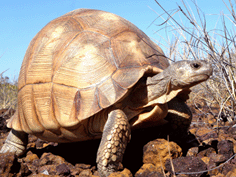Wasted efforts: why captivity is not the best way to conserve species
DOI:
https://doi.org/10.4314/mcd.v6i2.3Keywords:
Chelonians, captive-breeding, conservation strategies, conservation effectiveness, Madagascar.Abstract
Conservation strategies of Malagasy turtles and tortoises are based principally on the captive-breeding of these species, with the ultimate aim of their possible reintroduction in the wild. Given the current precarious conservation status of endemic Malagasy turtle and tortoise species, it is clear that approach has been a failure. Instead of being used to complement in situ approaches, for a number of years captive-breeding efforts have been used as an alternative. It is essential to develop conservation strategies for these species based on empirical data, and not only on the subjective vision of NGOs with a strong interest in ex situ conservation approaches. It is only by fighting the causes of decline of Malagasy chelonian species in the wild that they will be able to be saved.
RÉSUMÉ
Les stratégies de conservation des tortues malgaches reposent principalement sur l’élevage en captivité de ces espèces, en vue de leur possible réintroduction dans la nature. Force est de constater que cette approche a conduit à un échec, au regard du statut actuel, particulièrement précaire, des tortues endémiques malgaches. Au lieu d’appuyer les efforts de conservation in situ comme il se doit, l’élevage en captivité s’est substitué à eux, et ce depuis de nombreuses années. Il est désormais essentiel d’élaborer les stratégies de conservation de ces espèces sur la base de données empiriques, et non plus sur la seule vision subjective d’ONGs présentant un fort intérêt pour l’approche ex situ. C’est seulement en combattant les causes du déclin des tortues malgaches qu’il sera possible d’assurer leur survie.
References
Britt, A., Welch, C., Katz, A., Iambana, B., Porton, I., Junge, R., Crawford, G., Williams, C. and Haring., D. 2004. The re-stocking of captive-bred ruffed lemurs (Varecia variegata variegata) into the Betampona Reserve, Madagascar: Methodology and recommendations. Biodiversity and Conservation 13, 3: 635–657. (doi:10.1023/B:BIOC.0000009497.24917.ae)
Congdon, J. D., Dunham, A. E. and Van Loben Sels, R. C. 1994. Demographics of common snapping turtles (Chelydra serpentina): Implications for conservation and management of long-lived organisms. American Zoologist 34, 3: 397–408. (doi:10.1093/icb/34.3.397)
Dodd, C. K. and Seigel, R. A. 1991. Relocation, repatriation, and translocation of amphibians and reptiles: Are they conservation strategies that work? Herpetologica 47, 3: 336–350.
Frazer, N. B. 1992. Sea turtle conservation and halfway technology. Conservation Biology 6, 2: 179–184. (doi:10.1046/j.1523-1739.1992.620179.x)
Juvik, J. O., Andrianarivo, A. J., Blanc, C. P. and Bour, R. 1982. Revised species recovery plan for the endangered Madagascar angulated tortoise (Geochelone = Astrochelys yniphora). Unpublished proposal to the Department of Water and Forests of Madagascar and the World Wildlife Fund.
Kuchling, G. 1997. Captive propagation of Erymnochelys madagascariensis and a tortoise and turtle exhibit at Ampijoroa. Unpublished report to Conservation International and Jersey Wildlife Preservation Trust.
Lees, C. M. and Wilcken, J. 2009. Sustaining the Ark: The challenges faced by zoos in maintaining viable populations. International Zoo Yearbook 43, 1: 6–18. (doi:10.1111/j.1748-1090.2008.00066.x)
O’Brien, S., Emahalala, E. R., Beard, V., Rakotondrainy, R. M., Reid, A., Raharisoa, V. and Coulson, T. 2003. Decline of the Madagascar radiated tortoise Geochelone radiata due to overexploitation. Oryx 37, 3: 338–343. (doi:10.1017/S0030605303000590)
Ogle, M. and Hudson, R. 2008. Supporting efforts to protect Madagascar’s endemic tortoises – TSA launches new program. Turtle Survival Alliance Newsletter, August 2008: 36–39.
Pedrono, M. 2008. The Tortoises and Turtles of Madagascar. Natural History Publications (Borneo). Kota Kinabalu, Sabah, Malaysia.
Pedrono, M., Smith, L. L., Clobert, J., Massot, M. and Sarrazin, F. 2004. Wild-captive metapopulation viability analysis. Biological Conservation 119, 4: 463–473. (doi:10.1016/j.biocon.2004.01.007)
Seal, U. S. 1986. Goals of captive propagation programmes for the conservation of endangered species. International Zoo Yearbook 24, 1: 174–179. (doi:10.1111/j.1748-1090.1985.tb02535.x)
Snyder, N. F. R., Derrickson, S. R., Beissinger, S. R., Wiley, J. W., Smith, T. B., Toone, W. D. and Miller, B. 1996. Limitations of captive breeding in endangered species recovery. Conservation Biology 10, 2: 338–348. (doi:10.1046/j.1523-1739.1996.10020338.x)
Soulé, M., Gilpin, M., Conway, W. and Foose, T. 1986. The millennium ark: How long a voyage, how many staterooms, how many passengers? Zoo Biology 5, 2: 101–113. (doi:10.1002/zoo.1430050205)
Tudge, C. 1992. Last Animals at the Zoo: How Mass Extinction Can Be Stopped. Island Press, Washington, D.C.
Walker, R. C. J. 2010. The decline of the critically endangered northern Madagascar spider tortoise (Pyxis arachnoides brygooi). Herpetologica 66, 4: 411–417. (doi:10.1655/09-047.1)

Downloads
Published
Issue
Section
License
All journal content, except where otherwise noted, is licensed under a creative common Attribution 4.0 International and is published here by the Indian Ocean e-Ink under license from the author(s).


